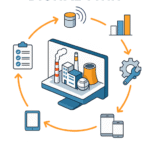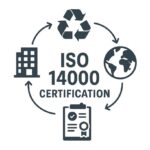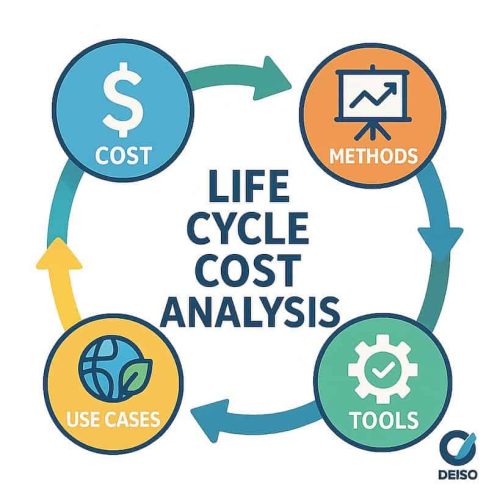
Table of Contents
📘 Section 1: Introduction — What is LCCA and Why It Matters
Life Cycle Cost Analysis (LCCA) is a decision-making method used to evaluate the total cost of a system, product, or project across its entire lifespan. Unlike traditional cost assessments that focus on upfront prices, LCCA considers everything from acquisition to disposal, enabling smarter and more sustainable financial planning.
At its core, LCCA answers one key question:
🔍 “What is the total cost of owning or operating this over time — not just today?”
🌍 Why LCCA Is More Important Than Ever
In today’s global economy, decision-makers face growing pressure to:
Optimize spending over time.
Build sustainable and resilient systems.
Meet ESG goals and government regulations.
LCCA empowers organizations to achieve all three. It enables better capital allocation, prevents costly surprises, and supports long-term value creation.
📘 Section 2: The 5 Key Cost Components in LCCA
To understand how LCCA works in practice, it’s essential to break down the five core cost categories it includes. Each category contributes to the Total Cost of Ownership (TCO) and must be evaluated to make informed decisions.
🧩 1. Initial Costs
These are the costs incurred at the beginning of the asset’s life:
Purchase price
Design and engineering
Installation and setup
🔹 Example: Buying a solar panel system includes the price of panels, installation, and grid integration.
🔌 2. Operating Costs
These are ongoing costs during use:
Energy or fuel consumption
Staffing or labor
Insurance and supplies
🔹 Example: A fleet of electric vehicles will have lower fuel costs but may need specialized charging infrastructure.
🛠️ 3. Maintenance and Repair Costs
These include:
Routine servicing
Unexpected breakdowns
Replacement of worn components
🔹 Example: Cheaper HVAC systems often require more frequent maintenance, raising their lifetime cost.
🧾 4. End-of-Life Costs
These are incurred when the asset is retired:
Decommissioning
Disposal or recycling
Environmental remediation
🔹 Example: Some electronics have disposal fees or environmental impacts that add to total cost.
💰 5. Discounting Future Costs
LCCA uses financial techniques like:
Net Present Value (NPV)
Discount Rate Adjustments
These ensure future costs are fairly compared to today’s values.
🔹 Example: A high maintenance cost in 10 years may seem small today — unless it’s discounted accurately
📌 Why It Matters
These five categories help businesses and governments:
Avoid hidden costs
Accurately compare options
Justify sustainable investment
🤝 DEISO’s Role
DEISO builds custom LCCA models tailored to each client’s industry and needs. We factor in:
Accurate cost breakdowns
Realistic assumptions
Discounting best practices
This allows our clients to confidently choose the best-value option, not just the cheapest.
🖼️ [Insert visualization here: Lifecycle Cost Breakdown Diagram]
✅ Please confirm if you’d like me to generate the colorful square visualization showing the 5 cost components connected with
🤝 How DEISO Helps
DEISO provides expert guidance on applying LCCA in real-world settings. We help organizations:
Analyze total costs over time.
Select optimal solutions.
Align financial decisions with sustainability targets.
Whether you’re building infrastructure, designing products, or evaluating operations, DEISO’s global team can help you embed LCCA in your decision-making.
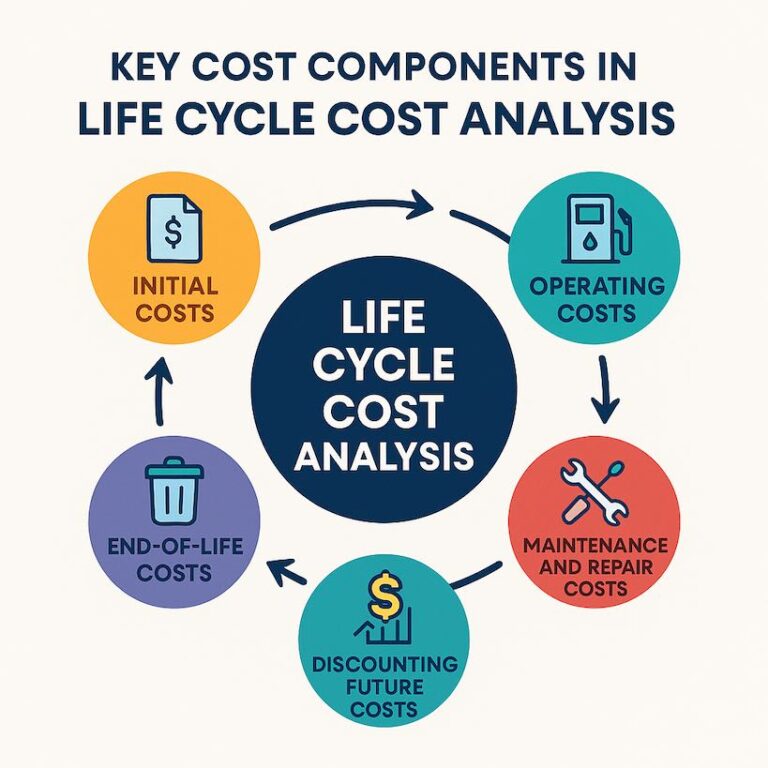
📘 Section 3: Real-World Use Cases — Buildings, Energy, and Products
LCCA becomes powerful when applied to real-world systems. Below are three example domains where Life Cycle Cost Analysis drives both cost efficiency and sustainable decisions, especially when implemented through DEISO’s expertise.
🏢 1. Building Projects
Architects, engineers, and municipalities use LCCA to evaluate:
Insulation materials
HVAC systems
Window glazing
Roofing options
🔹 Example: A municipal building may choose a green roof that costs 20% more upfront but saves significantly on cooling and maintenance over 25 years.
DEISO’s Role: We assist in modeling different construction materials and technologies, guiding planners to select options with the lowest total cost of ownership while meeting green building standards.
⚡ 2. Energy Systems
Energy-intensive systems often hide costs in long-term operations and maintenance.
🔹 Example: A company evaluating solar panels vs. traditional power supply can use LCCA to see that although solar costs more initially, it offers the lowest cost per kWh over time.
DEISO’s Role: We perform side-by-side LCCA comparisons for energy assets—solar, wind, geothermal, and energy storage—helping decision-makers maximize returns on investment while reducing environmental impact.
📦 3. Product Design & Manufacturing
Product-based companies integrate LCCA to:
Assess design choices
Evaluate material substitutions
Forecast maintenance and return cycles
🔹 Example: A manufacturer redesigns a machine component using a higher-grade alloy. While costlier up front, it cuts replacements by 70% over the life cycle.
DEISO’s Role: We partner with manufacturers and designers to integrate LCCA into product development processes—supporting decisions that reduce costs and improve lifecycle performance.
💡 Why Use Cases Matter
Use cases show LCCA is not theoretical—it directly informs capital planning, R&D, sustainability policy, and purchasing.

📘 Section 4: How DEISO Helps — Services, Tools & Training in LCCA
At DEISO, we go beyond theory — we help organizations around the world turn LCCA insights into real business value. Whether you’re planning infrastructure, developing products, or designing sustainability strategy, we offer tailored support in three core areas:
🛠️ 1. Consulting Services
DEISO builds and delivers custom LCCA models that reflect your real-world constraints and industry-specific variables.
We help clients:
Assess and compare investment options
Model full life cycle financial scenarios
Identify opportunities for long-term savings
🔹 Example: A renewable energy developer in Europe asked DEISO to evaluate multiple storage technologies. We created side-by-side LCCA models that revealed one option had 22% lower total cost of ownership — despite a higher upfront cost.
💻 2. Tools & Software Integration
Our experts support teams in integrating LCCA into:
Excel-based financial models
LCA software (e.g., SimaPro, OpenLCA)
Enterprise sustainability systems (ERP, ESG dashboards)
We also guide clients in choosing the right discount rates, cost categories, and boundary assumptions, ensuring that their cost analysis is rigorous and credible.
🎓 3. Training Programs & Capacity Building
We offer:
Beginner and advanced LCCA training
Custom workshops for universities, companies, and public-sector teams
Remote and onsite delivery
🔹 Example: A government agency trained by DEISO applied LCCA to public procurement and saved over $500K in 18 months by avoiding low-cost bids that had high maintenance burdens.
🌍 Why Clients Trust DEISO
Our team of economists, engineers, and sustainability professionals understand that real-world decision-making requires both numbers and insight. That’s why our services are not one-size-fits-all — we tailor LCCA to each client’s goals, data, and context.
✅ Whether you’re modeling renewable energy, green buildings, or product redesigns, DEISO delivers clarity, credibility, and value.
📘 Section 5: Common Pitfalls & The Future of LCCA
Even though LCCA is a powerful tool, its value depends on correct usage. Missteps in method or assumptions can lead to wrong conclusions and missed opportunities.
⚠️ Common Pitfalls in LCCA
1. Focusing Only on Upfront Costs
Organizations often ignore future maintenance, energy, or replacement costs — making decisions that appear cheaper but are costlier over time.
🔹 Example: A school district chose lower-cost HVAC units, only to face 4x higher repair costs over 10 years.
2. Using Incorrect Discount Rates
Choosing the wrong discount rate distorts cost comparisons. A too-high rate underestimates long-term impacts; a too-low rate overvalues future costs.
🔹 DEISO Tip: We help clients select proper rates based on industry, inflation, and policy goals.
3. Leaving Out Critical Life Cycle Phases
Some LCCA models ignore end-of-life costs or assume identical operating conditions, leading to flawed comparisons.
🔹 Example: Ignoring disposal fees in electronics procurement can underestimate total cost by 15–20%.
4. Poor Data Assumptions
Lack of real-world input data can weaken LCCA results. Generic assumptions don’t reflect operational realities.
🔹 DEISO Solution: We work with your teams to validate data inputs and build confidence in LCCA outcomes.
🔮 The Future of LCCA
LCCA is evolving with digital transformation and sustainability demands. Here’s what’s next:
-
AI + LCCA: Intelligent systems that optimize decisions using predictive LCCA modeling.
-
Digital Twins: Simulating building or product life cycles before they’re built.
-
Green Procurement: LCCA will be a mandatory metric in public tenders and ESG scoring.
🔹 DEISO Insight: We’re pioneering AI-integrated LCCA solutions for energy, infrastructure, and manufacturing sectors.
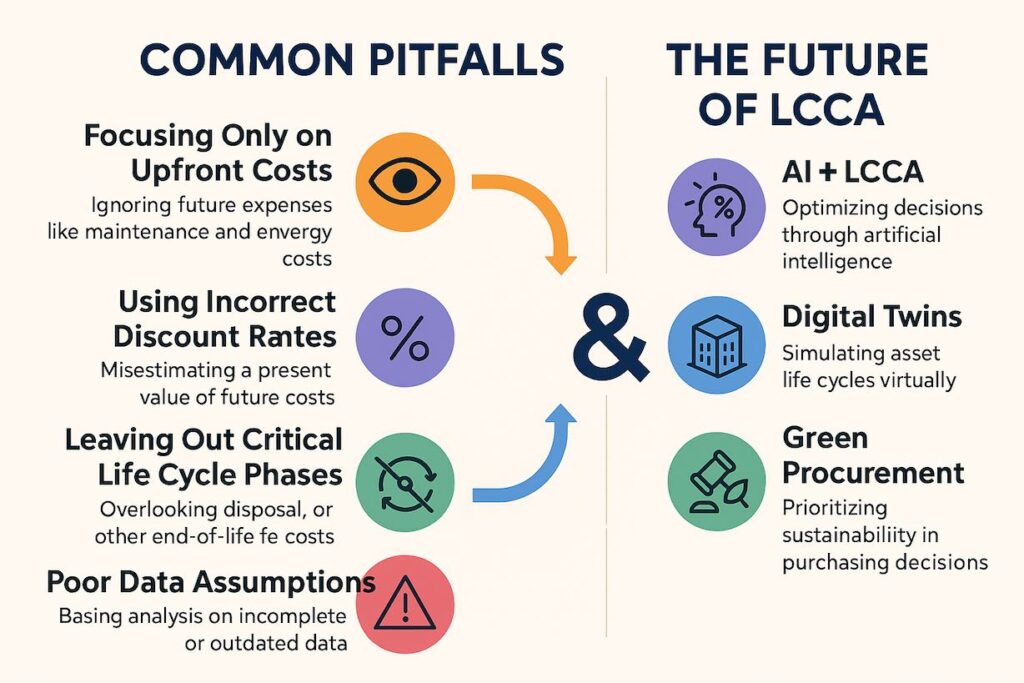
📘 Section 6: Calculated Case Study — Life Cycle Cost Analysis in Action
Let’s walk through a complete LCCA calculation using a real-world example:
Comparing two HVAC systems for a commercial office building over a 20-year period.
| Feature | System A (Basic) | System B (High-Efficiency) |
|---|---|---|
| Initial Cost (IC) | $8,000 | $12,000 |
| Annual Operating Cost | $1,600 | $1,000 |
| Annual Maintenance | $400 | $300 |
| Expected Life | 20 years | 20 years |
| End-of-Life Cost | $500 | $400 |
| Discount Rate | 5% (0.05) | 5% (0.05) |
🧮 Step-by-Step LCCA Formula
We’ll calculate the Net Present Value (NPV) of total life cycle cost using:
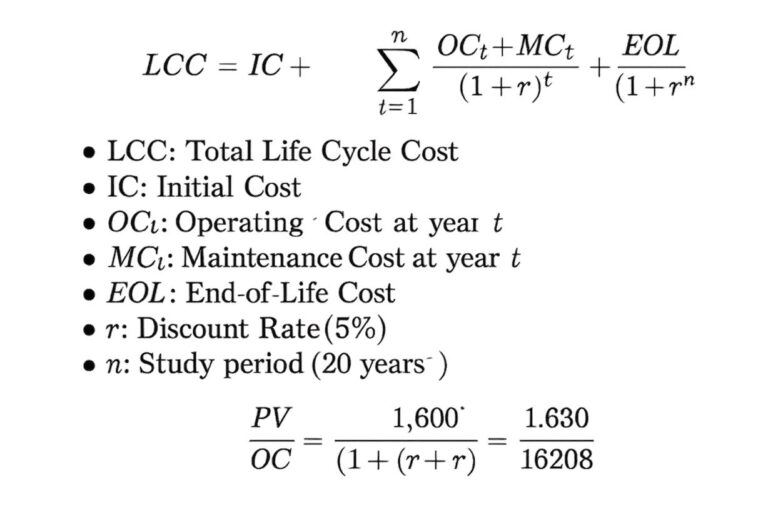
🔢 Step 1: Calculate PV of Recurring Costs (OC + MC)
We’ll use the Present Value of an Annuity formula:
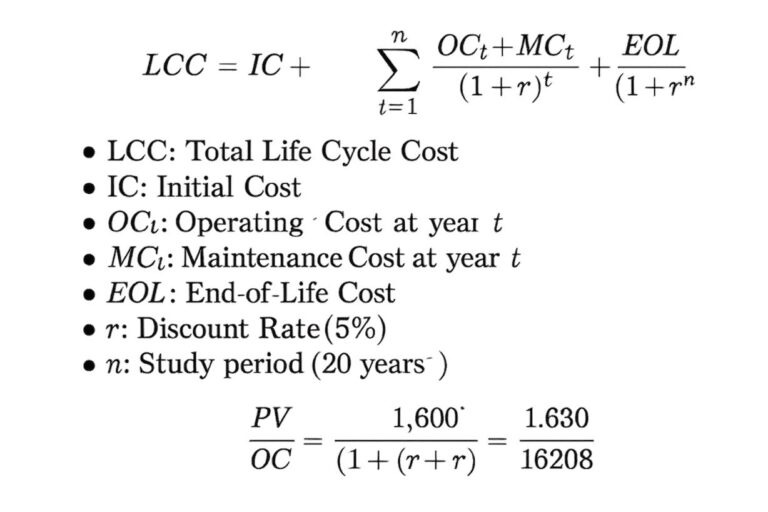
🔢 Step 2: Discount the End-of-Life Cost
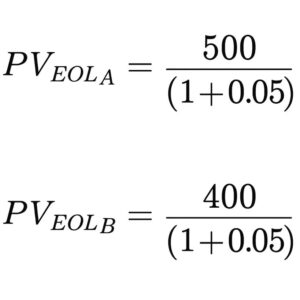
Step 3: Total Life Cycle Cost Comparison
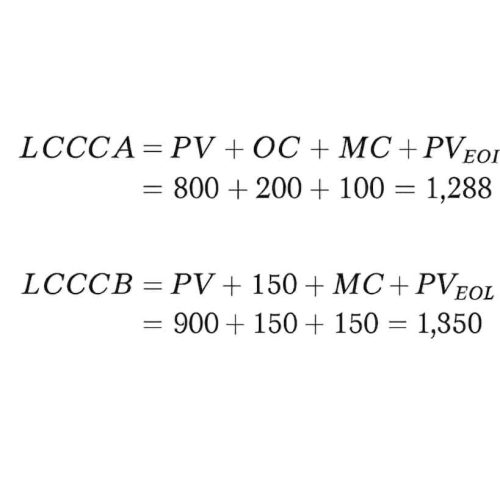
✅ Detailed Table: Full LCCA Breakdown
| Component | System A (Basic) | System B (High-Efficiency) |
|---|---|---|
| Initial Cost (IC) | $8,000 | $12,000 |
| Annual Operating Cost (OC) | $1,600 | $1,000 |
| Annual Maintenance Cost (MC) | $400 | $300 |
| Present Value of OC + MC | $24,924.40 | $16,200.86 |
| Discounted End-of-Life Cost | $188.49 | $150.79 |
| Total Life Cycle Cost (LCC) | $33,112.89 | $28,351.65 |
| Total Savings (A - B) | — | $4,761.24 |
📘 Section 7: Integrating LCCA and LCA — A Unified Approach to Sustainable Decision-Making
True sustainability requires understanding both the environmental and financial consequences of a decision. While LCA (Life Cycle Assessment) measures environmental impact, LCCA (Life Cycle Cost Analysis) evaluates total economic cost. When combined, they provide a comprehensive, data-driven framework for sustainable planning.
🔄 How LCA and LCCA Work Together
| LCA (Environmental) | LCCA (Economic) |
|---|---|
| Quantifies impacts like GHG, toxicity | Calculates total cost over life span |
| Used to compare eco-footprint of options | Used to compare cost-efficiency of options |
| Applied in green certifications | Applied in budget planning & procurement |
| Example tool: SimaPro, OpenLCA | Example tool: Excel, financial models |
✅ Together, LCA + LCCA inform sustainable design, procurement, and product decisions.
🧩 Real Integration in Action (Example)
A company is evaluating four façade materials for a building project:
Aluminum Cladding
Concrete
Wood Cladding
Brick
📊 LCA + LCCA Trade-off Chart
🖼️ [Visual shown: A scatter plot comparing Total Life Cycle Cost (x-axis) and GHG emissions (y-axis)]
Key findings:
Aluminum Cladding is costly and high-impact.
Wood Cladding has low cost and low environmental impact — the ideal sustainability pick.
Brick falls in a mid-range, offering balanced trade-offs.
Concrete is high-impact and moderate in cost.
🎓 DEISO’s Dual Expertise in LCA + LCCA
DEISO helps clients merge both disciplines for complete decision-making. Our services include:
💻 Model integration: Combine environmental data with financial models.
🔍 Trade-off visualization: Graphical interpretation for boards and stakeholders.
🎓 Premium training programs:
Full courses on LCA (tools like SimaPro, OpenLCA)
Full courses on LCCA (Excel-based, project-based)
Real-world project modules to practice integration
✅ Why It Matters
Clients who use LCA + LCCA together consistently make smarter, justifiable, and profitable sustainability decisions.
📘 Conclusion: Toward Smarter, Sustainable Decisions with LCCA + LCA
Sustainability is no longer a theoretical goal — it is a financial, operational, and environmental imperative. Life Cycle Cost Analysis (LCCA) empowers organizations to make economically sound decisions over the long term, while Life Cycle Assessment (LCA) ensures those decisions align with environmental responsibility.
But alone, each has limits. Together, they form a complete framework for evaluating total impact — both on the planet and on the balance sheet.
💡 Why Their Integration Matters
When LCCA and LCA are used in isolation:
You may choose a product that is cheap but polluting.
Or a solution that is eco-friendly but financially unsustainable.
When combined:
You identify sustainable, cost-effective solutions.
You make data-driven trade-offs with full visibility.
You future-proof your investments against environmental, economic, and regulatory risks.
🚀 DEISO: Your Partner in LCCA + LCA Excellence
At DEISO, we offer:
✅ Premium training programs in both LCCA and LCA
✅ Integrated modeling solutions that merge cost and environmental data
✅ Consulting support for project teams, engineers, policy makers, and sustainability leads
Whether you’re building infrastructure, designing new products, or preparing an EPD, DEISO helps you make smarter, greener, and more profitable decisions.
📘 Sustainable success begins with full lifecycle thinking — environmental and financial. That’s why the future belongs to organizations who master both.
Ready to lead with LCCA and LCA? We’ll help you every step of the way.
🌿 Advance Your Sustainability Goals with DEISO
🔧 Expert Services in LCCA & LCA
DEISO offers comprehensive services in Life Cycle Costing (LCCA) and Life Cycle Assessment (LCA), tailored to help businesses make informed, cost-effective, and environmentally responsible decisions.
Life Cycle Costing (LCCA): Analyze the total cost of ownership and make strategic financial decisions.
Life Cycle Assessment (LCA): Assess environmental impacts across the product lifecycle.
🔗 Explore DEISO’s Storytelling-as-a-Service (SaaS)
🎓 Professional Training Programs
Empower your team with DEISO’s specialized training programs, designed to build expertise in sustainability practices.
LCCA Advanced Training: For professionals aiming to deepen their understanding of life cycle costing.
🔗 LCCA Training ProgramLCA Professional Training: Comprehensive courses covering various aspects of life cycle assessment.
🔗 LCA Training Programs
🤖 AI-Powered Sustainability Solutions
Leverage DEISO AI to enhance your sustainability initiatives with advanced analytics and intelligent decision-making tools.
📞 Connect with DEISO
Ready to take the next step towards sustainable excellence? Contact the DEISO team to discuss your project needs or training requirements.
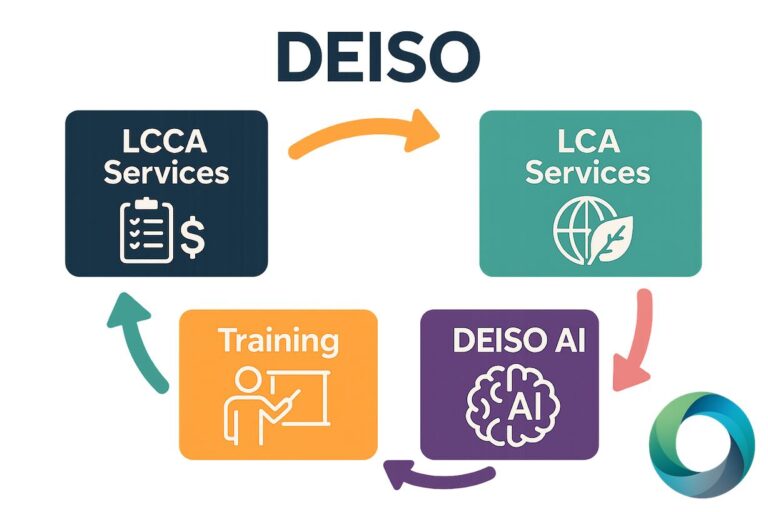
Share this:
- Click to email a link to a friend (Opens in new window) Email
- Click to share on LinkedIn (Opens in new window) LinkedIn
- Click to share on X (Opens in new window) X
- Click to share on Facebook (Opens in new window) Facebook
- Click to share on WhatsApp (Opens in new window) WhatsApp
- Click to share on Reddit (Opens in new window) Reddit
- Click to print (Opens in new window) Print
- More
- Click to share on Tumblr (Opens in new window) Tumblr
- Click to share on Threads (Opens in new window) Threads
- Click to share on Pinterest (Opens in new window) Pinterest
- Click to share on Pocket (Opens in new window) Pocket
- Click to share on Telegram (Opens in new window) Telegram
- Click to share on X (Opens in new window) X




